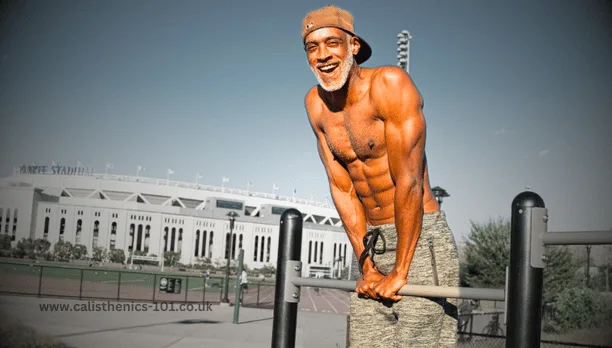It’s not uncommon to find people who believe that one can’t exercise after they have passed a certain age, which is a belief that is not rooted in reality.
In fact, calisthenics, a form of strength training that uses your body weight for resistance, offers a fantastic way to stay active and healthy well into your golden years. And age should never be a barrier to maintaining or improving your physical fitness.
In fact, calisthenics can be an ideal choice for older adults. This simple and effective workout approach focuses on functional movements like squats, push-ups, and planks, helping you enhance strength, flexibility, and balance.
Whether you’re a complete beginner or someone with prior fitness experience, this guide will show you that staying fit is achievable at any age. Get ready to unlock a new level of vitality and kickstart your fitness journey!
Table of Contents
How Calisthenics Can Be Beneficial for Seniors
Calisthenics is an excellent fitness option for seniors because it’s adaptable, low-impact, and provides a wide range of health benefits. Incorporating regular calisthenics exercises into your routine can help you stay active, healthy, and independent as you age.
Here are some key reasons why calisthenics can be highly beneficial for individuals over the age of 50.
1. Low Impact
One of the primary advantages of calisthenics for seniors is that it’s low-impact. Unlike activities like running or lifting weights, calisthenics training puts minimal stress levels on your joints. This means less risk of injury and a more comfortable calisthenics workout experience, making it ideal for those with joint issues or arthritis.
2. Improves Strength
As we age, we naturally lose muscle mass and strength. Calisthenics helps combat this by targeting multiple muscle groups through strengthening exercises like squats, push-ups, and planks. Regular practice can significantly improve overall strength, even with age-related muscle loss being a factor, making daily activities easier and reducing the risk of falls.
3. Enhances Flexibility
Maintaining flexibility is crucial as we age to prevent stiffness and improve the complete range of motion. Many calisthenics movements, such as leg swings and arm circles, help enhance flexibility, keeping your body limber and agile.
4. Boosts Balance
Balance tends to decline with age, increasing the likelihood of falls. Calisthenics exercises that involve standing on one leg or performing a range of motion that challenges stability can help seniors improve their balance, reducing the risk of accidents.
5. Promotes Cardiovascular Health
While calisthenics primarily focuses on strength and flexibility, it can also elevate your heart rate, providing cardiovascular benefits. Engaging in a series of bodyweight exercises in a circuit-style workout can improve your heart and lung health over time.
6. Weight Management
Maintaining a healthy weight becomes more challenging as we age, but calisthenics can assist with weight management. Regular exercise helps lose fat, build muscle, and pave the way for a healthier lifestyle. This can help seniors maintain a healthy weight and manage conditions like diabetes and high blood pressure.
7. Enhances Mood And Mental Health
Exercise, including calisthenics, releases endorphins, which are natural mood boosters. Seniors who engage in regular physical activity often experience reduced stress, improved mood, and enhanced cognitive function, helping them maintain a positive outlook on life.
Best Exercises For Over 50
Calisthenics exercises can be a fantastic way for seniors to improve their strength, flexibility, and overall fitness. These exercises use your own body weight as resistance, making them low-impact and suitable for individuals over 50.
Let’s explore some of the best calisthenics exercises for seniors, focusing on their ease of execution to receive all the benefits of a healthy physique.
1. Chair Squats
Target Muscles
Legs (quadriceps, hamstrings), Glutes
How to Do It
- Stand in front of a sturdy chair with your feet apart.
- Extend your arms forward for balance, if needed.
- Lower your body by bending your knees and hips as if you were about to sit in the chair.
- Keep your chest up and your weight in your heels.
- Hover a few inches above the chair or gently tap it with your buttocks.
- Push through your heels to stand back up.
Benefits
Chair squats are an excellent endurance training exercise to strengthen your leg muscles and improve your ability to perform everyday activities like sitting and standing. They also help with balance and stability.
2. Wall Push-Ups
Target Muscles
Chest, Shoulders, Triceps
How to Do It:
- Stand facing a wall, about arm’s length away.
- At shoulder height, place both hands on said wall wider than your shoulders.
- Move back a little so your body is at a slight angle.
- Maintain a straight form for your body from head to heels.
- Bend your elbows and push your chest toward the wall.
- Push against the wall to return to the standing position.
Benefits
Wall push-ups are a safer alternative to traditional push-ups, working the upper body and helping to maintain upper body strength. They can also improve posture and chest muscle tone.
3. Side Plank with Dip
Target Muscles
Core (obliques), Shoulders, Hips
How to Do It
- Lie on your side with your legs straight and your elbow directly under your shoulder.
- Lift your hips backwards off the ground, creating a straight head-to-heel line.
- Support your own body weight on your forearm and the side of your foot.
- Hold the side plank position for a few seconds.
- Slowly lower your hips toward the ground without touching it.
- Lift your hips back up to the side plank position.
Benefits
The side plank with a dip is an excellent exercise to strengthen your core, particularly your oblique muscle mass. It also helps improve shoulder stability and can enhance balance and posture.
4. Standing Calf Raises
Target Muscles
Calves
How to Do It
- Stand upright with your feet hip-width apart, near a sturdy surface for balance if needed.
- Raise your heels as high as possible by pushing through the balls of your feet.
- Hold the top position briefly.
- Lower your heels back down to the ground.
Benefits
Calf raises are great for building strength in the calf muscles, which are essential for balance and stability. Strong calves can help prevent falls and improve walking and stair climbing.
5. Seated Leg Raises
Target Muscles
Quadriceps (front thigh muscles)
How to Do It
- Sit on a chair with your back straight and feet flat on the floor.
- Extend one leg straight in front of you while keeping the other foot on the ground.
- Hold the extended leg in the air for a few seconds.
- Lower it back down and repeat with the other leg.
Benefits
Seated leg raises are a simple but effective exercise for strengthening the quadriceps, which are important for mobility and getting in and out of chairs.
6. Arm Circles
Target Muscles
Shoulders
How to Do It:
- Stand with your feet shoulder-width apart.
- Extend your arms straight out to the sides.
- Make small circles with your arms, moving them forward for a set amount of time.
- Reverse the direction of the circles and move your arms backwards for the same duration.
Benefits
Arm circles are an easy way to improve shoulder mobility and flexibility. They can also help reduce tension in the shoulders and upper back.
Tips For Performing Calisthenics Over 50
Performing calisthenics over the age of 50 can be highly beneficial, but it’s essential to approach it with care and consideration for your body’s unique needs. Here are some practical tips to help you get started and stay safe while enjoying the benefits of calisthenics:
1. Consult A Healthcare Professional
Before beginning any bodyweight training program, especially if you have underlying health issues or haven’t been active for a while, consult with your doctor or a qualified healthcare provider. They can offer personalised guidance and ensure your safety.
2. Start Slowly
Start calisthenics with a light exercise regimen and progress at your own pace. Focus on proper form and technique rather than trying to do too much too soon. This training approach reduces the risk of injury and allows your body to adapt to more advanced or physically intensive calisthenic exercises like pull-ups or jumping jacks.
3. Proper Form Is Key
Pay close attention to your form during each exercise. Maintain proper alignment and posture to avoid too much strain on your joints and muscles. If you’re unsure about your form, consider working with a qualified fitness trainer or using an app like the Movement Athlete app.
4. Listen To Your Body
Be attuned to how your body feels during and after exercise. If you experience discomfort, pain, or feel unusual, stop the exercise and consult a professional. Working out despite the pain can lead to injuries.
5. Stay Hydrated
Drink plenty of water before, during, and after your workout to prevent dehydration. Proper hydration is crucial for overall health and exercise performance.
6. Rest And Recovery
Your body needs time to rest and heal after calisthenics, and taking breaks between workouts helps functional strength and muscle recovery. Try to make sure to rest for at least 48 hours after intense strengthening exercises to allow yourself to keep exercising without hurting yourself and continue improving.
Final Words
Age should never be a barrier to staying active and healthy by starting calisthenics. It’s a fitness approach that offers numerous benefits for seniors, enhancing strength, flexibility, and overall well-being.
The training programs discussed in this guide are accessible and effective, providing an opportunity for seniors to maintain their fitness levels. By following the provided tips, consulting with healthcare professionals, and prioritising safety, individuals over 50 can enjoy a fulfilling calisthenics journey that promotes longevity and vitality.
No matter your skill level, embrace calisthenics, develop muscle and unlock a healthier, more active lifestyle in your golden years.

Founder of www.calisthenics-101.co.uk. Training calisthenics since 2012.
Currently working on: 30 second one-arm handstand, muscle-up 360, straddle planche.

Hi there,
Thank you for your great articles about calisthenics. I feel really inspired to start. I am 52, fairly fit (have been doing HIIT workouts daily, 20 minutes each morning, for the past 3 years.). However, I have hip pain in my right hip when I wake up in the morning especially. So I am looking for a different form of exercise, easier on the joints. Are there any good YouTube channels for calisthenics workouts for seniors/beginners that you would recommend? Thank you in advance for your recommendations.
Hey Vanessa!
You may want to visit a local physio to check that out.
As for youtube channels, you could watch: “Senior Fitness With Meredith” or “Bodyweight warrior” with Tom Merrick as Tom focuses largely on mobility and flexibility as part of his routines.
Hope that helps